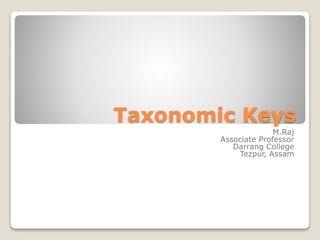
Taxonomic keys
- 1. Taxonomic Keys M.Raj Associate Professor Darrang College Tezpur, Assam
- 2. Identification Key Printed or Computer-aided device that aids the identification of biological entities plants animals fossils microorganisms pollen grains Keys are constructed so that the user is presented with a series of choices about the characteristics of the unknown organisms By making the correct choice at each step of the key, the user is ultimately led to the identity of a specimen While using a key at each step, the user must answer a question about one or more features (characters) of the entity to be identified. If each step has only two alternatives, the key is said to be dichotomous (also called "sequential key", "analytical key", or "pathway key"), else it is polytomous.
- 3. Why are identification keys necessary? A key is essentially a printed information-retrieval system into which one puts information regarding a specimen in hand and from which one gets an identification of the specimen to whatever level the key is designed to reach. In the absence of originally identified specimens of the species utilized for comparisons, the published description becomes the only tool. In larger groups however it is the most tedious task to compare specimens with hundreds of thousands of published descriptions. The task can be solved if the keys to the main group are made available. The main purpose of the key is thus to facilitate identification or to distinguish one type of organism or object from another. A key may or may not reflect ideas of evolutionary or phylogenetic relationship. The construction of the keys is an important job of the systematist.
- 4. Method of Using a Taxonomic Key It is necessary to read any introductory comments concerning the format of the key, abbreviations, and so forth, before using the key. One should always read both choices presented at each step of the key. Use a glossary to find the definition of any terms you do not understand. Use a ruler when measurements are required; do not guess. Because living organisms are always somewhat variable, one should not make a decision based on a single specimen; instead, it is much safer to arrive at a conclusion by examining several different specimens.
- 5. TypesofTaxonomicKeys Indented Key To indent means to begin a line or lines at a greater or less distance from the margin. The indented key then is one having an uneven, irregular border. The couplets in this key are indented from the left hand margin of the page, in such a way as to show their importance. Thus, the two or more members of the primary couplets are near the left hand margin, the secondary couplet is indented after leaving four or five spaces, the tertiary with equal number of spaces beyond the secondary and so on, to the end of the key. Advantage: This type of key is advantageous in the sense that the relationship of various divisions is quite apparent to the eye and can be used in reverse also. It serves good purpose for keys to higher taxa or comparative keys. Disadvantage: When the key is short, it works alright. But in long keys, the alternatives get widely separated and take more space. Moreover this can lead to much white space in print, and consequently little remaining room for lead text and illustrations.
- 6. TypesofTaxonomicKeys Simple Non-bracket key The couplets are composed of alternatives for ready comparison. The specimens to be identified are run through this key forward. It can be used from backwards but gives slight inconvenience in tracing the backward run of the characters to be compared
- 7. TypesofTaxonomicKeys Simple Bracket key It is similar to the simple non bracket key with the difference that the numbers of the couplets showing the situation in the key are shown in parentheses after the main numbers. This is the best key in fulfilling its diagnostic purpose and is a commonly used key by the present day taxonomists. Advantage: When properly constructed one can quickly and easily run through this key both forward and backward. It is also more economical in terms of space because it is un-indented. Disadvantage: The main disadvantage in both simple bracket and simple non bracket key types is that the relationship of the divisions is not apparent to the eye like indented key.
- 8. TypesofTaxonomicKeys Pictorial key Pictorial keys are of practical significance. It is especially meant for field workers and non-taxonomists that can identify the commonly occurring species with the help of characters together with their figures in a comparative manner. There are several such keys for various groups of animals. Box type key Like the branching and circular keys, the box-type key is also meant for field workers and quite useful for quick identification of most species
- 9. TypesofTaxonomicKeys Circular type key This key is also meant for small group. It is also quite useful for the non- specialists, especially field workers who want quick and and immediate identification of commonly occurring important species.
- 10. TypesofTaxonomicKeys Branching type key Such keys are also meant for easy and quick separation of the species as far as the group is small. It is quite useful for field workers.
